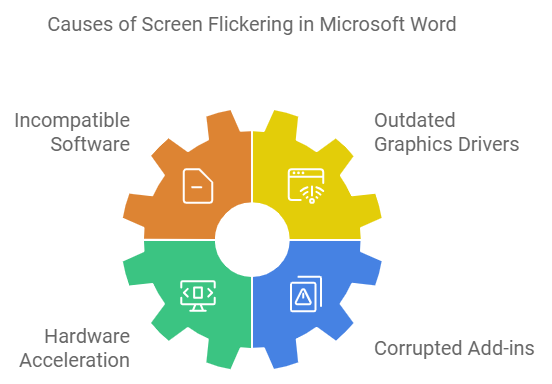Last Updated: January 24, 2025
If you’re experiencing glitches while working in Microsoft Word, you’re not alone. Many users face the frustrating issue of Microsoft Word screen flickering, which can interrupt your workflow and hinder productivity. This annoying visual disturbance can stem from various causes, like outdated software or display driver compatibility problems. Addressing Microsoft Word screen flickering is essential not just for immediate relief but also for maintaining a smooth and efficient user experience.
In this article, we’ll help you understand why this issue occurs and provide you with effective solutions to fix it. Say goodbye to distraction and hello to seamless document editing! Let’s dive into how to troubleshoot Microsoft Word screen flickering issues and ensure you can focus on what truly matters—your work.
Table Of Contents
Understanding Microsoft Word Screen Flickering
A. Definition and Common Causes of Screen Flickering in Microsoft Word
Microsoft Word screen flickering is an annoying issue that many users experience. It refers to the rapid shifting or blinking of the screen while working on a document. This can make it difficult to read or edit your work.
There are several common causes of screen flickering in Microsoft Word:
- Incompatible Software: If your version of Microsoft Word is not compatible with your operating system or installed applications, it may lead to flickering.
- Outdated Graphics Drivers: If the graphics drivers on your computer are outdated, they may not support Microsoft Word effectively, causing the screen to flicker.
- Hardware Acceleration: Microsoft Word uses hardware acceleration to improve performance, but sometimes, this feature can lead to screen flickering issues.
- Corrupted Add-ins: Sometimes, third-party add-ins can conflict with Microsoft Word, which may result in screen flickering.

Understanding what causes this problem is the first step toward fixing it. By knowing the triggers, you can take action to prevent and solve flickering issues.
B. Importance of Addressing Flickering Issues for Optimal User Experience
Addressing the Microsoft Word screen flickering problems is essential for several reasons:
1. Improved Focus: Flickering screens can distract you while you work. Fixing the issue allows you to concentrate better on your documents.
2. Enhanced Productivity: When the screen flickers, it can slow down your work process. Resolving the issue means you can work faster and complete tasks without interruption.
3. Health Benefits: Prolonged exposure to flickering screens can cause eye strain and headaches. By addressing the flickering issues, you protect your eyes and overall health.
4. Better Experience with Features: Microsoft Word has many amazing features that you might use. If your Word is flickering, you may miss out on using these features effectively.
5. Preserving Document Integrity: Continuous flickering might lead to unintentional mistakes, such as missing a change or editing the wrong section. Fixing the flickering issue helps you maintain the quality of your work.
By understanding the definition and causes of Microsoft Word screen flickering and the importance of addressing it, you’re better equipped to create a more comfortable working environment. Whether you are a student, professional, or casual user, resolving screen flicker issues will enhance your Microsoft Word experience. Stay tuned as we move to the solutions section of the article, where we will explore the steps to fix screen flickering efficiently.
Solutions to Resolve Microsoft Word Screen Flickering
Updating Software and Drivers to Fix Compatibility Issues
If you are facing the problem of Microsoft Word screen flickering, the first step is to ensure that your software and drivers are up to date. Outdated software can often lead to compatibility issues, which may cause screen flickering. Here’s how you can address this effectively:
Steps to Check for Updates in Microsoft Word
1. Open Microsoft Word: Launch the application on your computer.
2. Go to File Menu: Click on the File tab located in the upper left corner.
3. Select Account: From the sidebar, choose Account.
4. Update Options: Look for the Update Options button; click on it.
5. Check for Updates: Select Update Now. Microsoft Word will check for any available updates and install them automatically.
By keeping Microsoft Word updated, you ensure that you have all the latest features and bug fixes, which can significantly reduce screen flickering issues.
How to Update Graphic Drivers for Better Performance
Graphic drivers are crucial for how programs display on your screen. Keeping them updated can prevent Microsoft Word screen flickering too. Follow these steps:
1. Open Device Manager: Right-click on the Start button and select Device Manager.
2. Expand Display Adapters: Find the section labeled Display Adapters and click on the little arrow to expand it.
3. Right-click on Your Graphics Card: Choose your graphics card from the list, right-click it, and select Update Driver.
4. Select Search Automatically: Choose Search automatically for updated driver software. Your computer will look for any available updates and install them if any are found.
5. Restart Your Computer: After updating your drivers, restart your PC to apply changes.
Updating your graphic drivers can help tackle issues related to the rendering of Microsoft Word, thus minimizing screen flickering.
Adjusting Display Settings and Disabling Hardware Acceleration
Sometimes, Microsoft Word screen flickering can occur due to specific display settings or hardware acceleration features. By adjusting these settings, you might resolve the flickering problem.
Modifying Word’s Display Options for Smoother Operation
1. Open Microsoft Word: Start Word as you normally would.
2. Access Options: Click on File, then choose Options from the bottom.
3. Go to Advanced Settings: In the Word Options dialog, click on Advanced from the left menu.
4. Display Options: Scroll down to the Display section. Here, you can modify settings such as:
– Disable screen updates while editing: Check this box for smoother performance during typing.
– Show all formatting marks: Uncheck if it’s checked, as this can sometimes lead to visual disturbances.
These settings can help calm down any potential flickering caused by display overload.
Instructions for Disabling Hardware Graphics Acceleration in Word Settings
Hardware graphics acceleration can sometimes cause problems with display in Microsoft Word. Disabling this feature can help with flickering. Follow these steps to disable it:
1. Open Microsoft Word: Launch your Word application.
2. Access Word Options: Click on File, then select Options.
3. Advanced Tab: From the options list, click on Advanced.
4. Hardware Acceleration Settings: Under the Display section, find the checkbox labeled Disable hardware graphics acceleration.
5. Check the Box: Click to check this box.
6. Save Changes: Click OK to close the Word Options dialog.
Disabling hardware acceleration can greatly enhance the graphic performance of Microsoft Word and significantly lessen the chances of screen flickering.
Tips for Ongoing Maintenance
Regular maintenance of your software and settings is key to preventing further issues, including Microsoft Word screen flickering. Here are some tips:
– Regularly Check for Updates: Set reminders to check for updates monthly to keep all software, including Word and drivers, up to date.
– Perform Regularly Scheduled Maintenance: Consider using built-in tools or third-party maintenance software to optimize your computer.
– Keep an Eye on Resource Management: Monitoring your computer’s CPU and RAM usage can also help you spot problems before they become severe.
By following these solutions and tips, you can effectively tackle Microsoft Word screen flickering issues. A smooth and uninterrupted experience in Microsoft Word can make your work easier and more enjoyable.
For further details, go to Microsoft Community.
Wrap Up
Addressing the issue of Microsoft Word screen flickering is crucial for enhancing your productivity and ensuring a seamless working experience. Understanding the common causes, such as software incompatibility or outdated drivers, can help users proactively manage their Word environment.
By implementing the solutions we’ve outlined, from updating your software and graphics drivers to adjusting display settings and disabling hardware acceleration, you can effectively eliminate the annoying flickering and enjoy a more stable application. Remember that a few simple adjustments can go a long way in improving the performance of Microsoft Word.
If the flickering persists even after trying these solutions, consider reaching out to technical support or exploring additional resources online. Ultimately, maintaining the optimal functionality of Microsoft Word not only boosts your efficiency but also creates a more enjoyable document editing experience. Don’t let screen flickering distract you—take action today to enhance your Microsoft Word use!



